Ballot Measures

Nathalie Woolworth and Hazel Wong
This explainer is available in PDF format for non-commercial Creative Commons uses if it is shared with attribution and without remixing. We welcome your feedback. We encourage you to contact us if you decide to share it with a group.
Ballot measures, also known as initiatives or propositions, are instruments of direct democracy that allow voters to directly shape public policy in the voting booth. Measures at state and local levels have historically brought critical funding to land and water conservation across the country.
The Nature Conservancy (TNC) has been involved in 226 measures since 1987, resulting in the allocation of approximately $94 billion to protect our lands and waters.
While ballot measure wins have reaped large rewards for conservation in many states, it takes significant time, money and expertise to pass a measure. This is especially true at the state level. Depending on the size of the voter population and the initial level of support, local- and county-level measures typically require fewer resources.
Well-executed conservation campaigns require extensive upfront research to identify funding needs. The research should also examine state-specific laws governing ballot-measure processes. It should evaluate both political and financial feasibility.
Campaigns must also undertake public-opinion research to test which funding mechanisms are palatable to voters. To effectively garner votes, these measures must be backed by diverse coalitions. They also require adequate funding to communicate poll-tested messages through multiple media platforms. Even after ballot measures pass, the resulting programs must be monitored and defended with ongoing advocacy to ensure they are not rolled back.
For larger statewide measures, the levels of investment and expertise required to successfully run a campaign can limit the parties that can realistically spearhead this work. Large, professionalized organizations like TNC and Trust for Public Land (TPL) have historically led most state-level conservation campaigns in conjunction with local groups.
These organizations bring experience, expertise and funding to this work. They also offer the benefit of pre-established networks. While there are more opportunities for local organizing at the county level than at higher levels, many conservation campaigns are not “do-it-yourself” endeavors.
This article, which gives an overview of the process of passing a ballot measure, also sheds light on ways in which a variety of stakeholders can lend their support to this work at any scale.
How to Pass a Ballot Measure
- Understand State Laws. Conservation ballot measures are not one-size-fits-all solutions.
All states have some form of direct democracy except for Delaware. However, state laws governing ballot referendums and initiatives vary. Some states see direct democracy as conflicting with representative democracy, which has resulted in laws that make both initiative and referendum processes more costly and cumbersome.
Ballotpedia provides a comprehensive overview of the laws that govern direct democracy in all 50 states. Fully understanding state laws and processes is not easy. It is critical to access sound legal advice early in the process.
- Make the Case. Developing a compelling case for conservation funding includes identifying existing state or local needs.
Are existing programs underfunded? Are there funding gaps that require the creation of new programs? Conducting a needs assessment that includes the input of decision makers, public agencies, and community organizations can play a key role.
- Build a Coalition of Partners. To effectively pass a ballot measure, campaign organizers must assemble a strong coalition of partners that bring different strengths to the table.
A variety of stakeholders should be represented including community organizations, elected officials, the business community, and more.
Organizers should think about who needs to be involved to achieve success, how to best engage those parties, and how to negotiate the conflicting needs and desires of different stakeholders.
Successful campaigns focus on creating champions who believe in the campaign’s goals and embrace the hard work of raising awareness and persuading voters.
- Identify a Funding Mechanism. There are two ways to generate public funding for conservation using ballot initiatives: through the reallocation of existing general fund resources or the creation of revenues through a new tax or fee.
Specific finance mechanisms include general-obligation bonds, lottery-revenue income, sales-tax funding, corporate-business tax, and real-estate-transfer tax and fees, among others.
Preliminary research must be undertaken to understand different financial mechanisms and how much funding they could generate for conservation.
- Conduct Public-Opinion Research. Once funding mechanisms are identified, campaign organizers should conduct extensive public-opinion research.
This research allows organizers to test public support for conservation programs, identify financial sources, and consider ballot titles.
Research provides valuable insights into voters’ values, priorities, and views about conservation.
Polling also helps organizers decide how to compellingly communicate issues. Furthermore, research provides a critical way to test opposition messaging in order to gauge its impact in eroding public support.
Survey research and focus groups are expensive but necessary to understand the odds of winning and scale of resources required. In addition to polling, feasibility research should include investigation of voter demographics and political climate. The state or locality’s fiscal health is also important to examine.
- Draft Legislation. Drafting the legislation that will ultimately go to voters involves multiple steps and should rely on local legal advice. This process involves negotiations about where funds will be spent based on identified needs, coalition interests, and political feasibility.
If the measure is a referendum, it has to go through a legislative process involving numerous committee hearings and floor votes, which could result in many amendments.
Cultivating champions and building support through advocacy is especially critical in these instances. For signature-gathering processes in which the organizers draft legislation, it is critical to access legal advice to ensure that draft legislation is lawful and can withstand legal challenges.
While it is costly, the advantage of the signature-gathering process is that organizers can enact their preferred legislation within the state’s legal boundaries.
- Get the Ballot Language Right. Depending on the state, campaign organizers will have different degrees of influence on crafting the language that voters read on Election Day.
The phrasing of ballot questions is critical to success. Whether in an overt capacity or behind the scenes, organizers should be as involved as possible in ensuring that ballot language is simple and clear. It should state the specific benefits of the measure.
- Develop a Campaign. Once the groundwork for success has been laid through research and coalition building, it is time to launch a campaign to generate broad public support for the measure.
Campaigns should be developed around poll-tested messages that target key audience segments while retaining broad appeal. The scale of the measure and polling numbers will determine how much financial investment and staff are required to run a successful campaign.
At the county level, local leaders can organize and carry out field work themselves with the support of direct mail and campaign consultants.
Local organizers should rely heavily on coalition partners to socialize the idea with diverse stakeholders. State-wide measures require a more robust campaign infrastructure.
These campaigns typically include a professional manager and staff as well as consultants for polling, field work, and TV, direct mail, and online outreach.
- Raise Campaign Funds. Running an effective conservation campaign is expensive; larger state-level campaigns can cost millions of dollars. Campaign funds have to cover the costs of public opinion polling, campaign staff salaries, and voter media outreach. This outreach may involve online, print, TV and radio marketing.
Campaigns often rely on the financial support of coalition partners and private donors.
However, fundraising efforts are complicated by the fact that some non-profit groups, because of their IRS status, have limited resources to fund lobbying activities or voter outreach.
In addition to relying on coalition partners and their donors, organizers should formalize a fundraising committee. This group can focus on identifying donor prospects with high giving capacities and building compelling narratives about why donors are key to campaign success.
- Do Ongoing Advocacy. Once created, new sources of public funding may have to be defended. Or, in some cases, additional advocacy may be necessary to ensure money is being spent according to the enabling legislation passed by voters.
By showing overwhelming support for publicly-funded programs and demonstrating the high returns on investment that government funding generates, advocates can help to ensure these programs stand the test of time.
TPL’s analysis of the return on investment on Land for Maine’s Future program is an example of analysis that demonstrates the high-impact use of public dollars.
How to Assess the Risks and Rewards of Ballot-Measure Funding
Securing ballot measure funding is a huge win for conservation. Compared to other means of generating investment in land and water protection, the scale of ballot-measure funding is large.
In addition, this funding is earmarked solely for a host of conservation priorities. Given its scale and reliability, this capital can be leveraged to secure additional investment from private donors and other public sectors.
In many cases, securing public funds through a vote allows conservation organizations to move forward with land transactions that would otherwise stall because of funding deficits.
The forward-moving psychology that reliable sources of public funding encourage throughout the sector can expedite the pace and scale of protection, reaping huge rewards for conservation.
At the same time, conservation campaigns are not to be taken on lightly. Conservation advocates must commit significant time, energy and financial resources to the process of developing and executing a campaign, and ensure that they have the expertise to see the process successfully through.
In addition to losses of time and money, failures can be detrimental to future conservation efforts. Failed campaigns can cause elected officials to question whether supporting pro-conservation policies is a priority for their constituencies.
Conducting rigorous upfront research can help advocates to avoid involvement in ill-advised campaigns.
Where to Find Additional Resources
- Making the Most of Our Money: Recommendations for State Conservation Programs - This 2014 report, authored by Sandra Tassel of Look at the Land for TNC and TPL, provides an overview of state conservation programs across the country. The report identifies successes, challenges and opportunities associated with these programs.
- LandVote Database - This comprehensive database of conservation finance ballot measures, which is compiled by TPL, provides history, maps, tables and charts related to ballot measure funding across the country.
- Conservation Almanac – This resource, also compiled by TPL, provides information on federal, state, and local conservation spending.
- Water Funds Toolbox – TNC’s Water Funds Toolbox provides an overview of how to run a successful Conservation Campaign. This resource provides detailed information on the opinion polling and message development phases of a campaign.
Note: Our expert coauthors volunteer their time to assist our writers with these pieces.
To comment on this article, please post in our LinkedIn group, contact us on Twitter, or email the author via our contact form.

